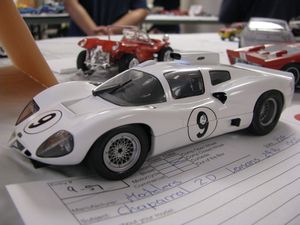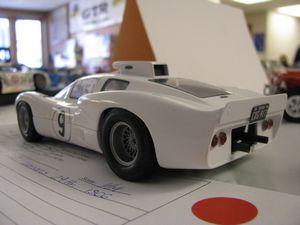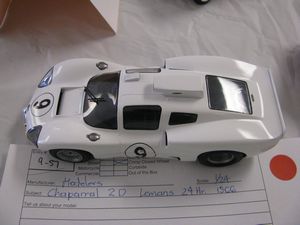















Chaparral 2D |
|---|

|
| Topic Navigation |
|---|
|
Wikipedia: Chaparral Cars: 2
Page Sections History Photographs |
History
The following section is an excerpt from Wikipedia's Chaparral Cars page on 25 May 2016, text available via the Creative Commons Attribution-ShareAlike 3.0 Unported License.
Background
Troutman and Barnes were builders of the original Chaparral race cars (later referred to as Chaparral 1). Jim Hall purchased two Chaparral 1s to race. When Hall and Sharp began building their own cars, they asked Troutman and Barnes if they could continue to use the Chaparral name. That is why the Hall/Sharp cars are all named Chaparral 2s (models 2A through 2J for sports cars/CanAm cars, and the 2K which was the 1979–1982 Indycar).
2
The first Chaparral 2-series was designed and built to compete in the United States Road Racing Championship and other sports car races of the time, particularly the West Coast Pro Series races that were held each fall. Hall had significant "under the table" assistance from GM, including engineering and technical support in the development of the car and its automatic transmission (this is evidenced by the similarity between the Chevy Corvette GS-II "research and development" car and the Chaparral 2A through 2C models).
First raced in late 1963, the Chaparral 2 developed into a dominant car in the CanAm series in 1966 and 1967. Designed for the 200 mile races of the CanAm series, it was also a winner in longer endurance races. In 1965 it shocked the sportscar world by winning the 12 Hours of Sebring in a pouring rain storm, on one of the roughest tracks in North America.
The Chaparral 2 featured the innovative use of fiberglass as a chassis material. The Chaparral 2C had a conventional aluminum chassis.
It is very difficult to identify all iterations of the car as new ideas were being tested continually.
The 2D was the first closed cockpit variant of the 2-series, designed for endurance racing in 1966. It won at 1000 km Nürburgring in 1966 with Phil Hill and Joakim Bonnier driving. It also competed in the 1966 24 Hours of Le Mans, withdrawing after 111 laps. The Chaparral 2D was equipped with a 327 cubic inch displacement (5.3 liter) aluminum alloy Chevrolet engine producing 420 horsepower, and the car weighed only 924 kg.
 |
Subject: 1966 Chaparral 2D as raced in the 1966 24 Hours of Le Mans
Photographer: Bill Crittenden Event: 2012 Summer NNL View photo of 1966 Chaparral 2D - 3.9MB |
 |
Subject: 1966 Chaparral 2D as raced in the 1966 24 Hours of Le Mans
Photographer: Bill Crittenden Event: 2012 Summer NNL View photo of 1966 Chaparral 2D - 3.6MB |
 |
Subject: 1966 Chaparral 2D as raced in the 1966 24 Hours of Le Mans
Photographer: Bill Crittenden Event: 2012 Summer NNL View photo of 1966 Chaparral 2D - 3.9MB |
